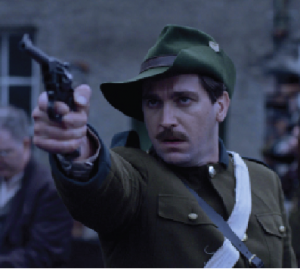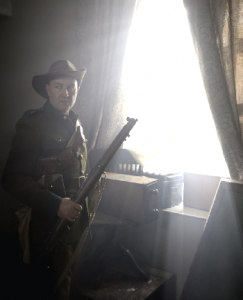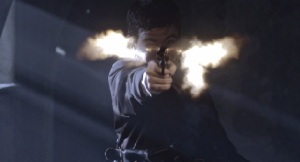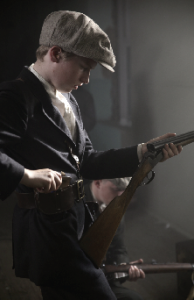Film eye: A terrible beauty
Published in 20th-century / Contemporary History, Feature Article, Issue 3 May/June2013, Reviews, Revolutionary Period 1912-23, Volume 21A terrible beauty
Title Films
by John Gibney

The dramatic reconstructions in A terrible beauty set the bar high for the documentaries that are bound to follow over the next few years.
The General Post Office on Dublin’s O’Connell Street looms large in the iconography of the Easter Rising. Its position on the main thoroughfare north of the River Liffey and its role as the headquarters of the ‘forces of the Irish Republic’ ensure that it remains synonymous with 1916. But as a victorious British Army picked up the pieces after the rising and sought to make sense of what had happened, they concluded that the most serious fighting they had faced in Dublin was not in O’Connell Street: it had been at Mount Street bridge and around the Four Courts, and the intense but semi-obscure fighting that took place in these areas is the subject of A terrible beauty.
The title is borrowed from the best-known line of the most famed literary response to the rising: W.B. Yeats’s Easter 1916. The title of the poem belies its complexity; to use the famous phrase as the title of this exceptionally well-made docu-drama belies the relative obscurity of its subject-matter. Pearse and Connolly are notably absent from this production; instead, the cast of characters consists of lesser-known Volunteers, members of Cumann na mBan, British soldiers and officers, and civilian victims.
A terrible beauty gets off to a brisk start, avoiding any detailed exegesis of the prelude to the rising in favour of establishing its context: the First World War, of which it was an integral part. This approach is especially appropriate here, given the emphasis on the British experience. This will be a novel perspective for many viewers but one that can hardly be disregarded: after all, they made up the vast majority of combatants in Dublin in April 1916.

A well-armed Volunteer sniper by a window. The Volunteers’ training was arguably superior to that of the soldiers they faced.
As becomes obvious while watching this assured film, the battle lines were not necessarily clear-cut. Take, for instance, Captain Frederick Dietrichsen, a Nottingham barrister who had enlisted in the Sherwood Foresters. His wife, Beatrice Mitchell, was Irish (one of the eponymous family of wine merchants), and he had sent her and their children back to Ireland during the war to avoid the danger of zeppelin raids. When she and the children came out to greet the soldiers who had arrived at Kingstown (a.k.a. Dún Laoghaire) to suppress the rebellion, they were pleasantly surprised to find that they were also greeting him. And he was dead that afternoon, shot along with hundreds of his colleagues after being ambushed at Mount Street bridge while attempting to cross the Grand Canal. They were attacked by Volunteers led by Michael Malone, whose brother, ironically, was killed in Flanders the previous year while serving in the Royal Dublin Fusiliers. Such ambiguities are revealed throughout the programme: from the confused Tommies who thought they had been sent to France, to the hostility of some Dubliners towards the insurgents who claimed to be fighting in their name.
A refreshing characteristic of A terrible beauty is its reluctance to revel in self-conscious debunking of ‘myths’; it reveals its nuances through the stories it tells, often in surprising ways. According to Chris Shouldice, the son of Jack and nephew of Frank (Volunteers whose testimonies are deployed in the film), the hoary old chestnut that the rising was a ‘blood sacrifice’ annoyed his father in later life: he and his colleagues had hoped to succeed. Proof of this could be found in the extent of the training in which the Volunteers engaged, which was arguably superior to that of the soldiers they faced. True, the Volunteers had not been tested in the furnace of the war, but neither had many of their opponents: by April 1916 the British Army was on the verge of becoming an exclusively conscript force, and the Sherwood Foresters were quite inexperienced. This was further compunded by the fact that the British Army was not used to street fighting, which was the exception rather than the rule on the Western Front. Another echo of the war was to be found in the arrogant obduracy of British officers who refused to let their men avoid the charnel-house at Mount Street bridge and Northumberland Road, and so condemned them to death at the hands of the Volunteers: 183 were killed or wounded there. In a macabre touch, after the rising the Sherwood Foresters were subsequently given the task of forming the firing squads that carried out the eventual executions.
 The other side of the story was to be found on North King Street, where, in the midst of the intense fighting around the Four Courts, the South Staffordshire Regiment sought to teach the natives a lesson. After indiscriminately firing into houses along the street, they deliberately killed thirteen civilians in five houses; some of the bodies were hastily buried. The indiscriminate prejudice that underpinned this atrocity foreshadowed the British attitudes that so alienated Irish nationalists after the rising; it was effectively covered up by an official inquiry that was unable to ascertain the precise circumstances and so found no individual soldier responsible. Nationalists viewed this as a cover-up, and had a valid point; Sir John Maxwell, the military governor appointed after the rising, publicly dismissed calls for inquiries into such deaths as enemy propaganda, but privately felt that innocent Irish civilians had indeed been killed in this way.
The other side of the story was to be found on North King Street, where, in the midst of the intense fighting around the Four Courts, the South Staffordshire Regiment sought to teach the natives a lesson. After indiscriminately firing into houses along the street, they deliberately killed thirteen civilians in five houses; some of the bodies were hastily buried. The indiscriminate prejudice that underpinned this atrocity foreshadowed the British attitudes that so alienated Irish nationalists after the rising; it was effectively covered up by an official inquiry that was unable to ascertain the precise circumstances and so found no individual soldier responsible. Nationalists viewed this as a cover-up, and had a valid point; Sir John Maxwell, the military governor appointed after the rising, publicly dismissed calls for inquiries into such deaths as enemy propaganda, but privately felt that innocent Irish civilians had indeed been killed in this way.

A teenage Volunteer reloads a shotgun.
(All images: Title Films
A terrible beauty is a measured and very impressive docu-drama. The unobtrusive English narration is by Peter Coonan (Fran the Man from Love/Hate), but a particularly effective way of telling the story is to have the actors, in character, tell the tales of the people they portray: the testimonies are taken from a wide range of sources and give a voice to the vivid human drama. Indeed, the dramatic reconstructions in A terrible beauty set the bar high for the documentaries that are bound to follow over the next few years. Having recently been shown in the Jameson Dublin Film Festival, a bilingual version of A terrible beauty is scheduled for a forthcoming theatrical release, and subsequently TG4 intend to broadcast an Irish-language version. This is an excellent and illuminating production that casts light on some of the less well-known aspects of the Easter Rising and, as such, is well worth watching. HI
John Gibney is History Ireland’s news editor.
Too purchase this DVD, please click here
















